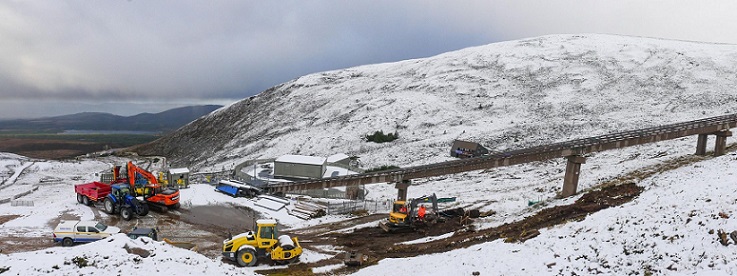
On 3rd November Highlands and Islands Enterprise announced that work to repair the funicular had started (see here). A large number of planning documents were published on the Cairngorms National Park Authority Planning portal the week before (see here). Among these is a timetable for the works:

It would appear work has commenced two months late. There was no explicit mention of this in HIE’s news release which says the intention is to “bring the Cairngorm funicular railway back into service in winter 2021/22”. But it explains the statement in the news release from Douglas Cowan, Director of Communities and Place at HIE that:
“The plan is to keep working for as long as possible during what remains of 2020, then resume as early as we can in the new year. That way, we can continue to keep the project on track to resume the service as planned in winter 2021/22.”
Unfortunately, while the CNPA appears to have done a good job in requiring HIE and Balfour Beatty to produce detailed plans for how they will protect the natural environment, it had set no conditions specifying when the work might be done. Working through the winter is very high risk from an environmental perspective For example, the surface of the new temporary access road (foreground of photo) will be exposed to both freeze thaw action and potentially large volumes of snow melt and could turn into a burn. It would appear at high risk of washing away, with the potential to create further serious damage below. Moreover, while the CNPA has required the turves to be carefully stored and re-used (they are visible in the photoby the side of the new road), the chance of this happening if they are left in situ for the next year appears very low.
It is of serious concern that in the first few days already parts of the plans appear to have been ignored.
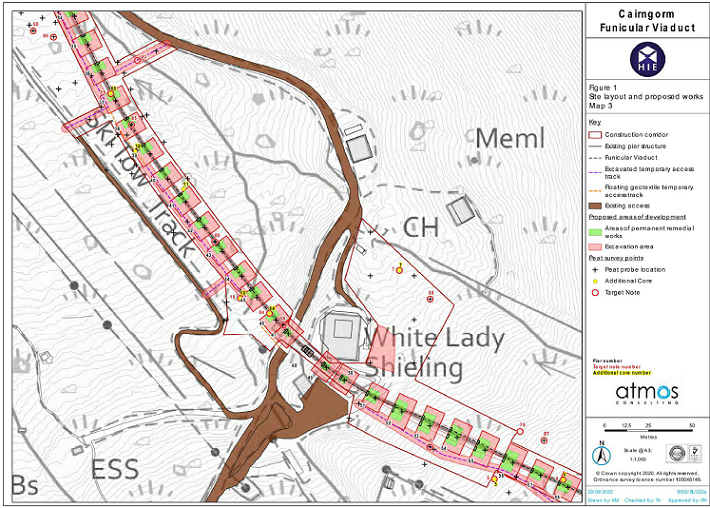
In the planning consent the CNPA required HIE/Balfour Beatty to provide information about the micro-siting of the temporary access road. The map from the site layout and works overview document, published on 30th October, shows the temporary access road, which will extend between pillars 51 and 63, running close to the funicular. The photo suggests the road is now being constructed on a different line. How map or photo fit with the claim in the Construction Method Statement that Balfour Beatty intended to uncover the original temporary construction road is unclear.
The photo also shows a yellow digger on what appears to be another road being excavated towards the area between pillars 51 and 52. That does not appear on any plans. The issue is that the further the temporary access road is located away from the funicular, the greater the number of spurs will be needed to access the funicular and the more ground that will be disturbed. On current evidence much of slope could be dug up. It seems clear that the CNPA needs to start monitoring the works at Cairn Gorm on an almost daily basis if the repairs to the funicular are not to create far more damage than its original construction (which was undertaken with the greatest care).
The CNPA should also be mindful of Drumochter, where Balfour Beatty was the contractor for the Beauly Denny powerline where so much damage has been done to what was supposed to be one of Scotland’s most protected areas (see here). The restoration efforts there were pitiful and the same most not be allowed to happen at Cairn Gorm. Just how HIE could have selected Balfour Beatty as contractor for the works at Cairn Gorm, without any competition or any consideration of their record working in sensitive areas, is another question the Scottish Parliament’s Audit and Post Legislative Scrutiny Committee (see here) should be asking.
The masterplan and the snow factory
Meantime, following the consultation earlier this year and the vision HIE launched in the summer (see here), there is still no sign of a masterplan for Cairn Gorm. After a spate of planning applications earlier this year, there was a lull over the summer before Cairngorm Mountain Scotland Ltd submitted another application on 28th August (see here for papers) requesting an extension of the temporary planning for the snow factory in the Coire Cas car park for another year:
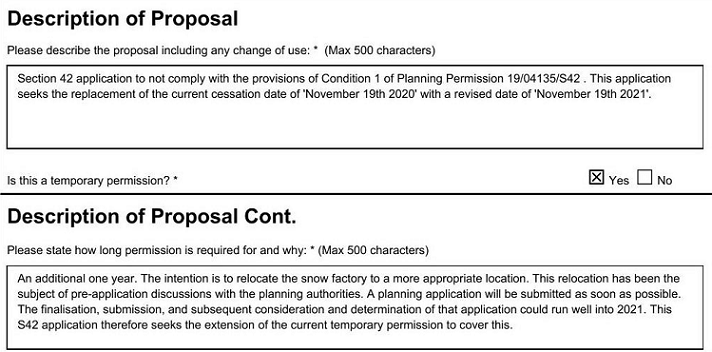
Two and a half months later there is still no sign of an application proposing a permanent application for the snow factory. Edward Mountain, MSP, in an article for the Strathy which called for structural changes in the way Cairn Gorm is managed (see here), last week put the issues succinctly when he stated:
“And we also need to sort out getting the snow to the top of the mountain – and not pushing snow uphill from a snow station that’s been built at one of the lowest points.”
The snow factory is in the worst possible place and the Cairngorms National Park Authority was right to call-in the planning application from Highland Council. What they can do is another question. It seems likely that having so far failed to come up with a coherent plan for downhill skiing, HIE now cannot move the snow factory without this interfering with the repair work on the funicular. If that is so, it has hard to see the snow factory being much use for next year either.
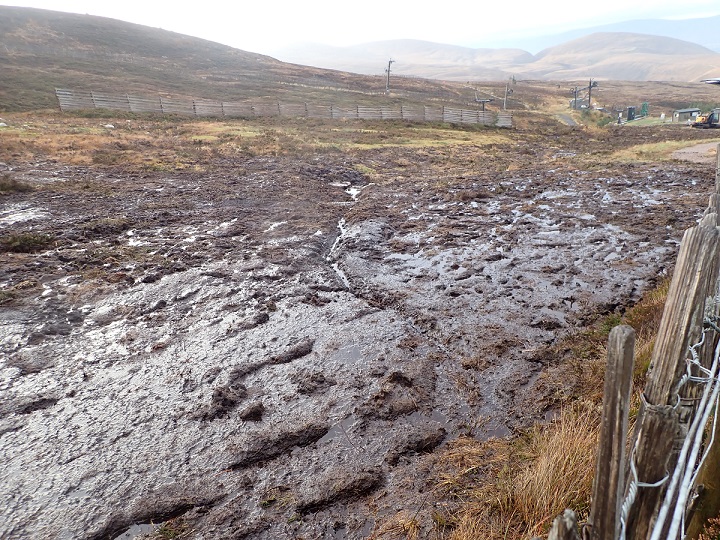
Meantime work on smoothing the slopes near the Day Lodge to create the new beginner’s ski area (see here) appears to have finished. While it is not all peat soup, apart from the environmental destruction (one wonders what impact a flash flood would have on this), it is difficult to think of a worse surface for artificial snow.
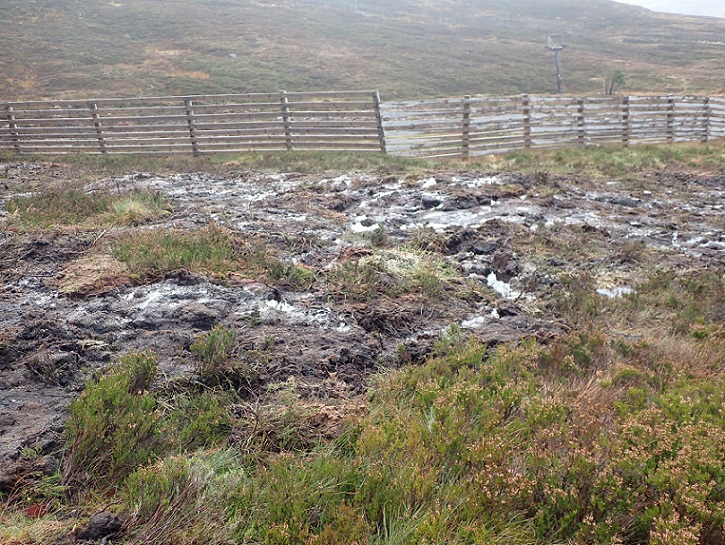 Unless the whole slope is frozen by a very hard frost, it looks as though much of the artificially created snow from the machines will melt into the mire. CMSL has announced these are due to start operating next week, planning permission or not. The evidence suggests that HIE’s claims that flattening this slope would improve snow retention is very much in the balance and that, whatever the weather, there is little for downhill skiers to look forward to at Cairn Gorm this winter.
Unless the whole slope is frozen by a very hard frost, it looks as though much of the artificially created snow from the machines will melt into the mire. CMSL has announced these are due to start operating next week, planning permission or not. The evidence suggests that HIE’s claims that flattening this slope would improve snow retention is very much in the balance and that, whatever the weather, there is little for downhill skiers to look forward to at Cairn Gorm this winter.Parkswatch intends to take a further look at the new funicular repair planning documents in due course and try and monitor closely what is happening on the ground. If you are passing by, do take photos (the good, the bad, the ugly, it’s the evidence that matters) and send them to me, Nickkempe@parkswatchscotland.co.uk.
Worth noting that the snow factory is in effect a very large heat pump. I would like to have seen an investigation into placing the snowfactory on the uphill side of the daylodge and heating the building with it, allowing to be out of view, reusing the waste heat and reducing the daylodge heating bills, alas nobody was interested.
As an alternative, the waste heat could be used to heat the Sheiling building if it is brought back into use. Regrettably, HIE do not engage meaningfully with any Stakeholder or Community Group and useful ideas are therefore ignored. Perhaps the consultants brought in to examine power generation and usage might bring forward some sensible ideas. Of course HIE have been known to pay consultants to examine an aspect of the business and then completely ignore their findings……..just as they did with a report into run of river Hydro power generation and more recently with Snowmaking.
Good article Nick. A lot of this was pointed out to the CNPA in my and others objections to the planning application and yet the CNPA board completely ignored facts that were presented to them. Even after mention was made of the historic tracks being used and then Ryden planning admitting that they did not know where they were the CNPA planners did nothing! But then anyone with a grain of common sense could see what was going to happen. HIE do what they want as usual with a complete disregard for the environment. An interesting point about the beginner area, which also appears to have been worked on outside the planning consent, if there is a big freeze it will become a giant skating rink, on which snow may not lie, dangerous to walk on and when it thaws imagine the muddy mess when the PBs etc. run over it. What an environmental and skiing disaster this work has the potential to be.
I look in dismay at your photograph of the ruined state of the ground! As you say a flash flood would cause even more destruction to the soil, notwithstanding the flora and fauna of the whole area.
How a lift like this was given permission to be built is the root of the problem.
NO SNOW no skiing I say!
Looks like all the mistakes made by HIE’s predecessors, Highlands and Islands Development Board, in the 1970s are being repeated 50 years later. Creating large areas of bare ground by construction activities in the winter is asking for trouble. Just read the evidence on erosion and downstream flooding that was given by Scottish and Swiss experts at the Lurchers Gully Public Inquiry in 1981, the last time any independent investigation was made into construction activities on this mountain. And remember, the ski road has been washed away three times already, due to intense rainstorms and land slips in the Allt Mor catchment which drains Coire Cas and adjacent areas. Perhaps the lessons will finally be learnt by the Scottish Government and HIE once the funicular has been repaired and we then find nobody can get to Coire Cas. It just needs the next rain storm to wash the road away, for the fourth time.
Dave Morris’s comments are entirely right. I sat through the six weeks of the public inquiry into ski development proposals in 1981 for the northern corries etc and the complete amateurism of HIDB etc as they then were was striking. Regarding susceptibility to erosion and flash flooding, as pointed out at that experts at that inquiry it is no just a question of bared ground. One effect that was pointed out to us on Cairngorm is that much subsurface drainage is through underground established channeled flows. Once you disturb surface layers badly, fine particles are loosened and wash down below surface and block these flows forcing them to surface as surface flows and on it goes. Another that happens is compaction of soils in depth by contractors as they move soils etc, greatly reducing their capacity to hold water. Adam pointed out that the alpine garden they planted had limited success because they did this to the subsurface layers. Lastly it is worth remembering that erosion on mountains is often not a gradual process. What mostly happens is that successive damage gradually increases the vulnerability of an area. Mountains are prone to occasional intensive weather events like intense rainstorms. One of these strikes when the extent of damage has created a very vulnerable area and the impact is a major dramatic and potentially dangerous event. That has happened widely in mismanaged mountain area and before on Cairn Gorm, and the current operations seem to be recreating just that scenario.
It’s a fair principle that the less suitable a site is, the more adaptation you have to do. This mountain has suffered an extraordinary amount of this, to the point where the final result might as well have been done on a brownfield site.
A sad saga of incompetence and indifference, motivated by greed.
Who is to blame? All of us: those who wanted it to happen, and those who let it happen.
What is to be done? Scottish government held to account?
Once again an office chair decision based on totally naive expectations by a committee who do not know enough about what is either efficient practical or possible. Now a whole ale mess is to be created through the winter months. The consequences will ripple down the watercourses for a generation . Of course there will be endless justification for delay and prevarication. This is certain to be used by contractors to justify a massive increase in costs. Why did no one look at the annual rainfall averages for this part of Scotland? Had they done this a plan for a swift program of works to install new components prepared indoors remotely was wiser, instead of working in arctic – at best sub-arctic – conditions in a quagmire. Those prepared to step outside their plush offices might note that from mid April through May and June across the eastern Highlands are the usually the driest, least hostile months…..?
It is a widely held belief in the civil service that a good civil servant can function effectivley in any job regardless of whether they have any knowledge of what they are dealing with. The effects of this culture results in incompetent decisions and exploitative contractors inflating prices.
With regard to the estimated costs of replacing the Funicular, St Gilgen in Austria replaced their old Zwölferbahn cable car with an 8 man gondola this year. It’s 2.7km long, rises 962m, with an uplift capacity of 1800 people per hour. The entire project, including the building of new top and bottom stations with toilets, ticket office and top station restaurant , cost 17m Euros, less than £15.5m. That’s enough height difference to go from Glenmore to the Ptarmigan, although that would require double the lift length. However this actual project again demonstrates the dubious cost estimates HIE are using to support repairing the Funicular rather than replacing it with the most widely used type of main uplift in the Alps.